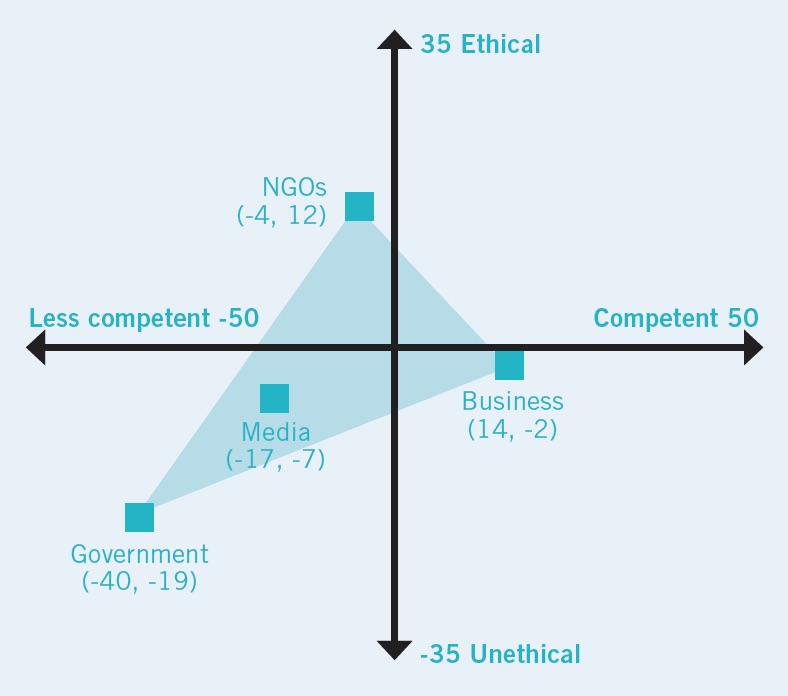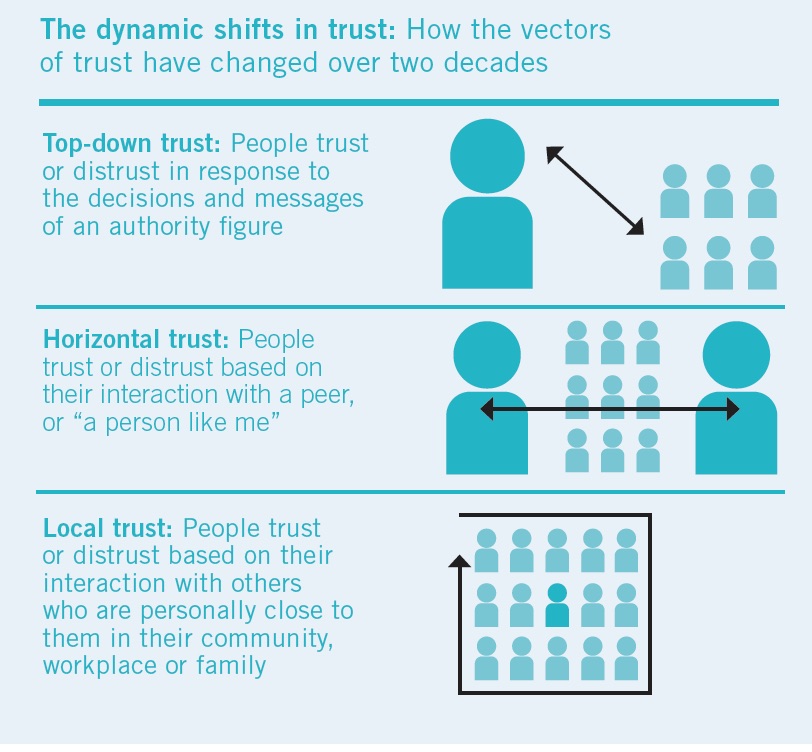Management: A Commitment, Not A Campaign

The following is an excerpt from Red Goldfish, Promo Edition.
Choosing purpose as a business practice is fraught with danger. For the latter part of the 2010s, social media became the land of “the Woke”—those willing to point out apparent hypocrisies, gender and racial biases, and other unacceptable behavior from the comfort of their smartphones. While statistical evidence supports the existence of an opportunity to connect with emerging buyer demographics using purpose as a strategy, there is considerable evidence to suggest that consumers are not only wary of insincere efforts, they’ve actually weaponized the court of public opinion to work against the perpetrator, often to the peril of sales results, dividend performance, and ultimately, the reputation of those brands seeking to connect using purpose. See Figure 1.
–––––––––––––––––––––––––––––––––––––––––––––––––––––––––––
![]()
The Nature of Trust HAs Changed
Trust: Competence and Ethics
Trust today is granted on two distinct attributes: competence (delivering on promises) and ethical behavior (doing the right thing and working to improve society.) Currently, no one institution is considered both competent and ethical.

Trust Moves Local
Trust has moved from a top-down vertical model, dependent on traditional leaders, to a horizontal one in which people rely more on friends, family and "a person like me."

–––––––––––––––––––––––––––––––––––––––––––––––––––––––––––
As referenced in the graphic, courtesy of Richard Edelman, author of the Edelman Trust Barometer, you can see consumer behavior and trust have shifted away from a top-down approach, where people were seen to trust or distrust directly as the result of belief (or the absence of belief) in authority figures and toward a more local version of trust, where people choose to trust or distrust based on input from friends, family and others who “are like me.”
Also of note are the foundational elements that comprise trust: competence (delivering on promises) and character (doing the right thing and working to improve society). As these elements of trust emerge in importance, it’s paramount for businesses to be able to communicate how they are walking their talk.
That being said, if you’re still up for the challenge, there are ways to navigate these perilous, trust-barren seas.
The size of your organization will often dictate how best to begin the process of aligning on purpose. Working in tandem with employees creates the best opportunity for long-term success, but examining opportunities for alignment in the boardroom amongst the leadership team often serves as a substitute. While it’s still better to have a plan with many stakeholders participating, it’s more important to begin than it is not to begin out of fear of a lackluster start, so if your efforts need to begin with the executive team only, in most instances that’s better than not starting at all.
The most important consideration in this exercise is authenticity. You can’t manufacture your desire to get behind something as a means to fool people into giving you their money. You have to have a sincere desire to build (or in most instances, remodel) your business to be a clearer reflection of what and who the people behind your business are all about.
Once you’ve hammered out how you intend to start, it’s vital that you make these efforts part of your business-planning process. Devoting time and attention to the development, implementation and measurement of your progress should be a part of your strategic planning efforts. By committing your efforts to the written parts of your business, you’ll remain attuned to the day-to-day activities necessary to demonstrate your newly crafted, purpose-driven status. With repetition comes improvement and consistent repetition requires commitment; a commitment that often will fade with time when not made a foundational aspect of the business plan.
Standing out in a sea of sameness requires focused attention on creating and fostering a differentiation strategy. By developing the purpose behind your business and committing to the activities that come along with doing so, you’re building a well-positioned differentiation strategy, a strategy that has consistently and repeatedly been shown to outperform the marketplace. It’s not simple to execute, and many businesses have made unsuccessful attempts to align on purpose, but those that are successful report results that would make any entrepreneur gleeful. The nature of the work changes when viewed through a purpose-driven lens, but the business outcomes have a tendency to be memorable when driven from a place of purpose.
Competitive differentiation was already a difficult proposition in the pre-COVID-19 economy, but a record-setting run of prosperity covered up a number of glaringly obvious problems that have been laid bare when the economy returned to the starting gate:
![]() Many businessowners started their business in the time since the 2008 Great Recession. They haven’t experienced this type of economic downturn and have no experience in handling the realities of a constrained marketplace.
Many businessowners started their business in the time since the 2008 Great Recession. They haven’t experienced this type of economic downturn and have no experience in handling the realities of a constrained marketplace.
![]() A booming economy created jobs for almost everyone. When there’s sufficient work to keep everyone busy, the need to stand out from your competitors is mitigated.
A booming economy created jobs for almost everyone. When there’s sufficient work to keep everyone busy, the need to stand out from your competitors is mitigated.
![]() Generational differences between late-career Baby Boomers and ambitious Millennials was already creating tension in the workplace; tension that has now morphed and grown with added layers of socioeconomic and racial tensions facing the American public. (Stan Phelps and Brian Doyle do a masterful job covering this generational concern in Gray Goldfish.)
Generational differences between late-career Baby Boomers and ambitious Millennials was already creating tension in the workplace; tension that has now morphed and grown with added layers of socioeconomic and racial tensions facing the American public. (Stan Phelps and Brian Doyle do a masterful job covering this generational concern in Gray Goldfish.)
As we move to the post-pandemic portion of our economic rebirth, it will be of specific interest to watch how the predictions made in the Richard Edelman graphic happen in each of our communities. It’s interesting to witness the localization of spending that can be seen in a robust open-air farmers market thriving in the face of the pandemic as shoppers seek more COVID-19-friendly environments to buy food coupled with a renewed interest in knowing where the products being bought were grown. Nothing like the farmer herself selling her produce to be sure of its origin.
Will emerging forces—like businesses aligning on purpose in the aftermath of all that’s occurred since January 1, 2020—be able to reverse the clear and obvious signs of peril that accompany a lack of competitive differentiation? We can be sure of more scarce resources for a prolonged period of time, likely dating well into 2021, and we are waiting for a credible vaccine to be distributed en masse. Will businesses aligned on purpose be able to reap a fast-start competitive advantage as the new economy presents itself?
There are a lot of unanswered questions at this point, but one thing is clear; there will be heightened expectations for brands and organizations. Businesses able to meet those expectations, or better yet, exceed them, not only will cement their brand in their buyers’ hearts and pocketbooks, they will champion a cause to all who will listen.
In the pages to come, we spotlight the ways purpose-driven businesses in the promotional marketing industry are doing their work; the ways those businesses are positively impacting the community, the environment, and humanity; and we investigate the many forms purpose takes when buyers of promotional marketing items activate good deeds with their purchases.
–––––––––––––––––––––––––––––––––––––––––––––––––––––––––––
Roger Burnett is co-founder of PromoCares and PromoKitchen, host of the So, You’re in Sales? podcast, executive producer of the PromoCares Radio podcast and co-author of Red Goldfish, Promo Edition. He offers a unique perspective on the many values of organizational alignment and the ways purpose capably serves as the fifth P of marketing. He is also founder of Social Good Promotions, a social enterprise built to teach and deliver purpose-based marketing strategies to businesses of all sizes while also donating marketing services to nonprofit organizations in the communities they serve.
Stan Phelps, CSP, is a world-renown speaker, author, workshop facilitator and masterful storyteller on customer experience, employee engagement, technology, differentiation, leadership and purpose. Prior to focusing on writing and speaking, he held leadership positions at IMG, adidas and the PGA, and spent seven years as chief solutions officer at Synergy, an award-winning marketing agency. He is author of the best-selling book series Purple Goldfish.
Red Goldfish, Promo Edition: How Promotional Products Leverage Purpose to Increase Impact, was released in September and is available on Amazon.

